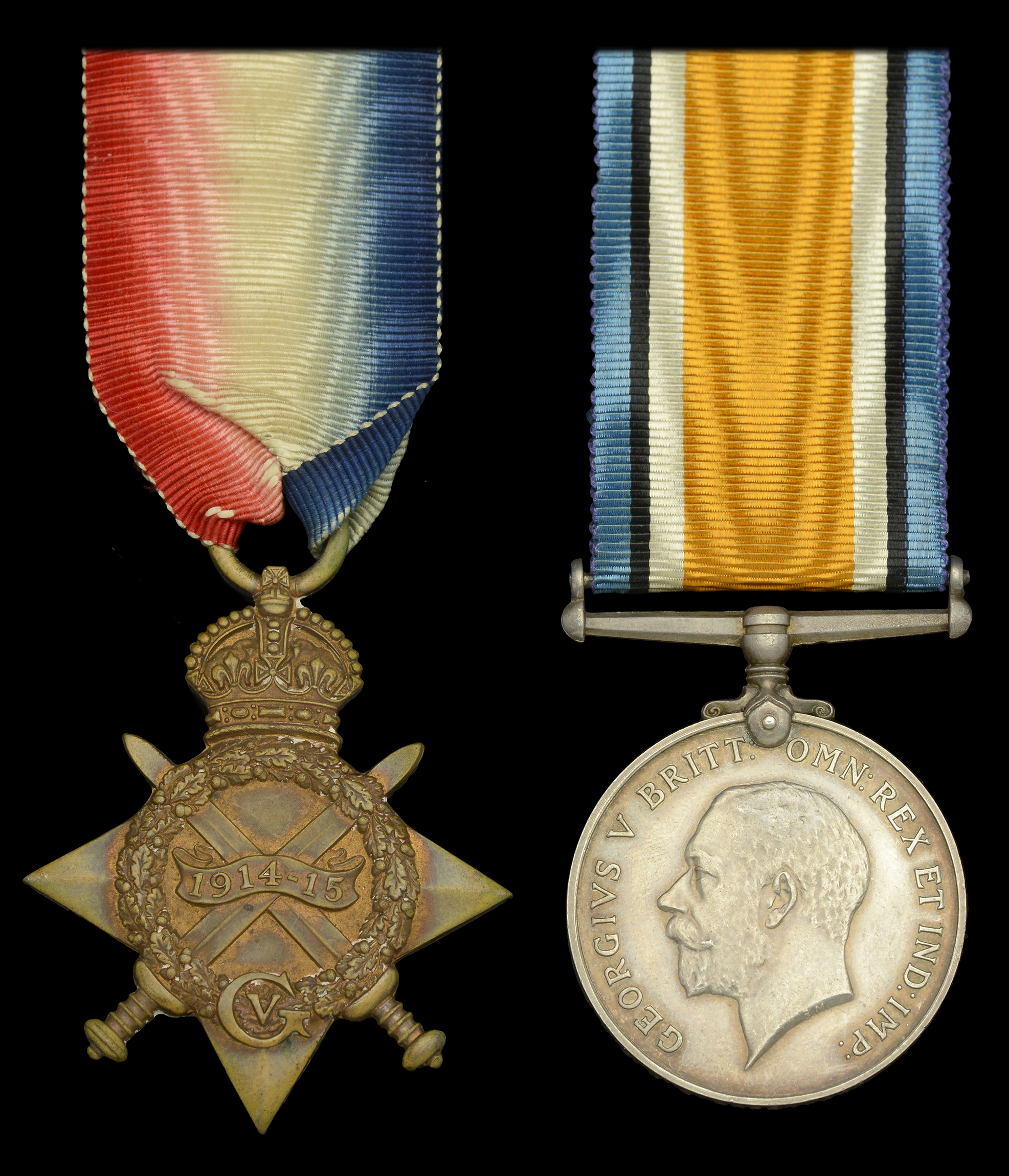129
Pair: Private J. B. Greenwood, 1/5th Norfolk Regiment, a member of the so-called 'Vanished...
Gebote sind ohne Steuern, Aufgeld oder Versankosten.
By confirming your bid, you agree that you have read and accepted the-saleroom.com and the auctioneer's terms and conditions. Confirming your bid is a legally binding obligation to purchase and pay for the lot should your bid be successful.
Wählen Sie eine der folgenden Schnellgebotsoptionen:
Gebote sind ohne Steuern, Aufgeld oder Versankosten.
By confirming your bid, you agree that you have read and accepted the-saleroom.com and the auctioneer's terms and conditions. Confirming your bid is a legally binding obligation to purchase and pay for the lot should your bid be successful.
1914-15 Star (3327 Pte. J. B. Greenwood. Norf. R.); British War Medal 1914-20 (3327 Pte. J. B. Greenwood. Norf. R.) extremely fine (2) £200-£240
---
Provenance: Dix Noonan Webb, March 2005.
John Beckett Greenwood attested for the Norfolk Regiment at Dereham, Norfolk, and served with the 1/5th Battalion during the Great War in Gallipoli from 10 August 1915. He was killed in action in Gallipoli on 12 August 1915, aged 27 years. He has no known grave and is commemorated on the Helles Memorial, Turkey.
The Vanished Battalion
The 1/5th Battalion Norfolk Regiment, the so-called ‘Vanished Battalion’, landed on ‘A’ Beach at Suvla on 10 August 1915; 48 hours later, the battalion ‘disappeared’ without trace during the attack on the Kuchak Anafarta Ova.
The total casualties of the 1/5th Battalion on this date were stated in the War Diary compiled by officers of the 4th Battalion, Norfolk Regiment to have been 22 officers and about 350 men. Of these, it is generally believed that 16 officers and around 250 men were classed as missing, but more recent research by Hal Giblin suggests a more likely total of 12 officers and 104 other ranks (see his article and roll of honour published in the O.M.R.S. Journal, Spring 1981). Certainly the confused fighting on that fateful day has resulted in considerable debate and differing contentions. Equally certain is that a large percentage of the Battalion, with Colonel Sir H. Proctor-Beauchamp, Bt., C.B., the C.O., at its head, literally disappeared without trace - he was last seen encouraging his men forward by waving his cane over his head and shouting ‘On the Norfolks on, come on my Holy Boys, forward the Hungry Ninth.’
In his despatch of 11 December 1915, Sir Ian Hamilton, the British Commander-in-Chief, referred to the unknown fate of the missing men of the 1/5th Norfolk Battalion as ‘a very mysterious thing’. He wrote:
‘The 1/5th Norfolk were on the right of the line and found themselves for a moment less strongly opposed than the rest of the brigade. Against the yielding forces of the enemy, Colonel Sir H. Beauchamp, a bold, self-confident officer, eagerly pressed forward, followed by the best part of the battalion. The fighting grew hotter, and the ground became more wooded and broken. At this stage many men were wounded, or grew exhausted with thirst. These found their way back to camp during the night. But the Colonel, with sixteen officers and 250 men, still kept pushing on, driving the enemy before them. Amongst these ardent souls was part of a fine company enlisted from the King’s Sandringham estates. Nothing more was ever seen or heard of any of them. They charged into the forest and were lost to sight or sound. Not one of them ever came back.’
The remains of the ‘Vanished Battalion’ were not discovered until 1919, when the Commonwealth War Graves Commission, working in Turkey to consolidate and record graves dating from the 1915 Dardanelles campaign, found 122 bodies. On 23 September 1919, the officer commanding the Graves Registration Unit in Gallipoli wrote in a report:
‘We have found the 5th Norfolks - there were 180 in all; 122 Norfolk and a few Hants. and Suffolks with 2/4th Cheshires. We could only identify two - Privates Barnaby and Cotter. They were scattered over an area of about one square mile, at a distance of at least 800 yards behind the Turkish front line. Many of them had evidently been killed in a farm, as a local Turk, who owns the place, told us that when he came back he found the farm covered with the decomposing bodies of British soldiers which he threw into a small ravine. The whole thing quite bears out the original theory that they did not go very far on, but got mopped up one by one, all except the ones who got into the farm.’
Modern accounts speculate that the missing were in all likelihood murdered by the Turks at this farm house, and the fact that the above 122 men were actually discovered in what amounted to a mass grave certainly lends weight to such a contention. That said, the Turks officially denied having even come into contact with the Battalion when enquiries were pressed after the War. The remains of those Norfolks recovered were buried in the Imperial War Cemetery at Azmak, Suvla, each grave being marked, ‘A Soldier of the 1/5th Btn. The Norfolk Regiment.’
Due to the fact that the fate of the men of the battalion was not immediately known, the date of death on official casualty lists (see Soldiers Died) is often given as ‘died 28 August’ - probably the date they were officially accepted as dead.
Sold with a copy of the book ‘All The King’s Men’, by Nigel McCrery.
1914-15 Star (3327 Pte. J. B. Greenwood. Norf. R.); British War Medal 1914-20 (3327 Pte. J. B. Greenwood. Norf. R.) extremely fine (2) £200-£240
---
Provenance: Dix Noonan Webb, March 2005.
John Beckett Greenwood attested for the Norfolk Regiment at Dereham, Norfolk, and served with the 1/5th Battalion during the Great War in Gallipoli from 10 August 1915. He was killed in action in Gallipoli on 12 August 1915, aged 27 years. He has no known grave and is commemorated on the Helles Memorial, Turkey.
The Vanished Battalion
The 1/5th Battalion Norfolk Regiment, the so-called ‘Vanished Battalion’, landed on ‘A’ Beach at Suvla on 10 August 1915; 48 hours later, the battalion ‘disappeared’ without trace during the attack on the Kuchak Anafarta Ova.
The total casualties of the 1/5th Battalion on this date were stated in the War Diary compiled by officers of the 4th Battalion, Norfolk Regiment to have been 22 officers and about 350 men. Of these, it is generally believed that 16 officers and around 250 men were classed as missing, but more recent research by Hal Giblin suggests a more likely total of 12 officers and 104 other ranks (see his article and roll of honour published in the O.M.R.S. Journal, Spring 1981). Certainly the confused fighting on that fateful day has resulted in considerable debate and differing contentions. Equally certain is that a large percentage of the Battalion, with Colonel Sir H. Proctor-Beauchamp, Bt., C.B., the C.O., at its head, literally disappeared without trace - he was last seen encouraging his men forward by waving his cane over his head and shouting ‘On the Norfolks on, come on my Holy Boys, forward the Hungry Ninth.’
In his despatch of 11 December 1915, Sir Ian Hamilton, the British Commander-in-Chief, referred to the unknown fate of the missing men of the 1/5th Norfolk Battalion as ‘a very mysterious thing’. He wrote:
‘The 1/5th Norfolk were on the right of the line and found themselves for a moment less strongly opposed than the rest of the brigade. Against the yielding forces of the enemy, Colonel Sir H. Beauchamp, a bold, self-confident officer, eagerly pressed forward, followed by the best part of the battalion. The fighting grew hotter, and the ground became more wooded and broken. At this stage many men were wounded, or grew exhausted with thirst. These found their way back to camp during the night. But the Colonel, with sixteen officers and 250 men, still kept pushing on, driving the enemy before them. Amongst these ardent souls was part of a fine company enlisted from the King’s Sandringham estates. Nothing more was ever seen or heard of any of them. They charged into the forest and were lost to sight or sound. Not one of them ever came back.’
The remains of the ‘Vanished Battalion’ were not discovered until 1919, when the Commonwealth War Graves Commission, working in Turkey to consolidate and record graves dating from the 1915 Dardanelles campaign, found 122 bodies. On 23 September 1919, the officer commanding the Graves Registration Unit in Gallipoli wrote in a report:
‘We have found the 5th Norfolks - there were 180 in all; 122 Norfolk and a few Hants. and Suffolks with 2/4th Cheshires. We could only identify two - Privates Barnaby and Cotter. They were scattered over an area of about one square mile, at a distance of at least 800 yards behind the Turkish front line. Many of them had evidently been killed in a farm, as a local Turk, who owns the place, told us that when he came back he found the farm covered with the decomposing bodies of British soldiers which he threw into a small ravine. The whole thing quite bears out the original theory that they did not go very far on, but got mopped up one by one, all except the ones who got into the farm.’
Modern accounts speculate that the missing were in all likelihood murdered by the Turks at this farm house, and the fact that the above 122 men were actually discovered in what amounted to a mass grave certainly lends weight to such a contention. That said, the Turks officially denied having even come into contact with the Battalion when enquiries were pressed after the War. The remains of those Norfolks recovered were buried in the Imperial War Cemetery at Azmak, Suvla, each grave being marked, ‘A Soldier of the 1/5th Btn. The Norfolk Regiment.’
Due to the fact that the fate of the men of the battalion was not immediately known, the date of death on official casualty lists (see Soldiers Died) is often given as ‘died 28 August’ - probably the date they were officially accepted as dead.
Sold with a copy of the book ‘All The King’s Men’, by Nigel McCrery.
Orders, Decorations, Medals and Militaria
Auktionsdatum
Ort der Versteigerung
Generelle Versandinformationen vom Auktionshaus verfügbar
If you are successful in purchasing lot/s being auctioned by us and opt for the item/s to be sent to you, we will use the following methods of shipment:
Within the UK
If you live within the UK, items will be despatched using Royal Mail Special Delivery. This service provides parcel tracking (via the Royal Mail website) and next weekday delivery (betwen 9am and 1pm). Items delivered within the UK are covered by our insurance company. Heavy and bulky lots will be sent by courier, in discussion with the client.
Outside of the UK
If the item/s being sent are worth under £1000 in total they are sent using Royal Mail’s Signed For International service. This ensures the item must be signed for when it is delivered.
If the item/s being sent are valued at over £1000 in total they will be sent using FedEx. This service allows next day delivery to customers in many parts of the US and parcels are fully trackable using the FedEx website.
Shipping Exceptions
Certain lots such as those containing glass or sharp implements, etc., may not be suitable for in-house shipping within or outside of the UK. Please contact Noonans with any queries.
Wichtige Informationen
Auctioneer's Buyers Premium: 24% (+VAT)
There is an additional charge of 4.95% (+VAT/sales tax)










